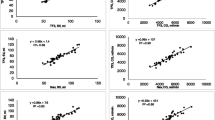Abstract
Azygos venous blood flow as an index of blood flow through the gastroesophageal collaterals and varices is of value in the prediction of gastrointestinal bleeding. Measurement of azygos venous blood flow has been achieved by non breath-hold (NBH) cine phase-contrast magnetic resonance imaging. The objective of this study was to compare the faster breath-hold (BH) phase-contrast technique with the standard (NBH) cine phase-contrast technique in the measurement of azygos blood flow. Thirty-two cirrhotic patients with esophageal varices were examined by magnetic resonance imaging using a BH technique and a NBH cine phase-contrast technique to measure the flow velocity, flow volume and calibre of the azygos vein at the mid-right atrial level. The flow values were obtained on the velocity image of the phase-contrast study. Values obtained from the two methods were evaluated statistically for the strength and significance of correlation by the Pearson test. Measurement by the BH method performed at full-inspiration as well as end-expiration was also obtained in 15 healthy volunteers. The breath-hold phase-contrast method has significant but weak correlation with non BH cine phase-contrast method in the measurement of azygos venous blood flow volume (r=0.55, p<0.01) and flow velocity (r=0.43, p=0.01). However, the calibre of the azygos vein gave a strong correlation in these two methods (0.82). In the subgroup of patients whose azygos blood flow velocity was greater than 7.4 cm/s, the correlation of azygos blood flow volume is strong (r=0.80, p<0.01). The azygos vein calibre remains highly correlated between the BH and NBH method, in both high flow velocity (r=0.73) and low flow velocity (r=0.83) groups. Breath-hold sequence leads to higher values for flow velocity and flow volume in the cirrhotic patients and also the control group. In patients with portal hypertension, BH 2D phase-contrast (PC) magnetic resonance angiography (MRA) could give a comparable estimation of the calibre of the azygos vein as the NBH 2D cine PC MRA but not for azygos flow volume. In patients with high azygos flow velocity, the strong correlation in flow volume between the BH and NBH method suggests that the BH method may be a time-saving alternative to the NBH method.
Similar content being viewed by others
Author information
Authors and Affiliations
Corresponding author
Rights and permissions
About this article
Cite this article
Ng, W., Chan, Y., Sung, J. et al. Comparison of breath-hold 2D phase-contrast with non breath-hold cine phase-contrast MRA in the assessment of azygos venous blood flow in portal hypertension. Magn Reson Mater Phy 16, 211–217 (2004). https://doi.org/10.1007/s10334-003-0026-4
Received:
Accepted:
Published:
Issue Date:
DOI: https://doi.org/10.1007/s10334-003-0026-4




